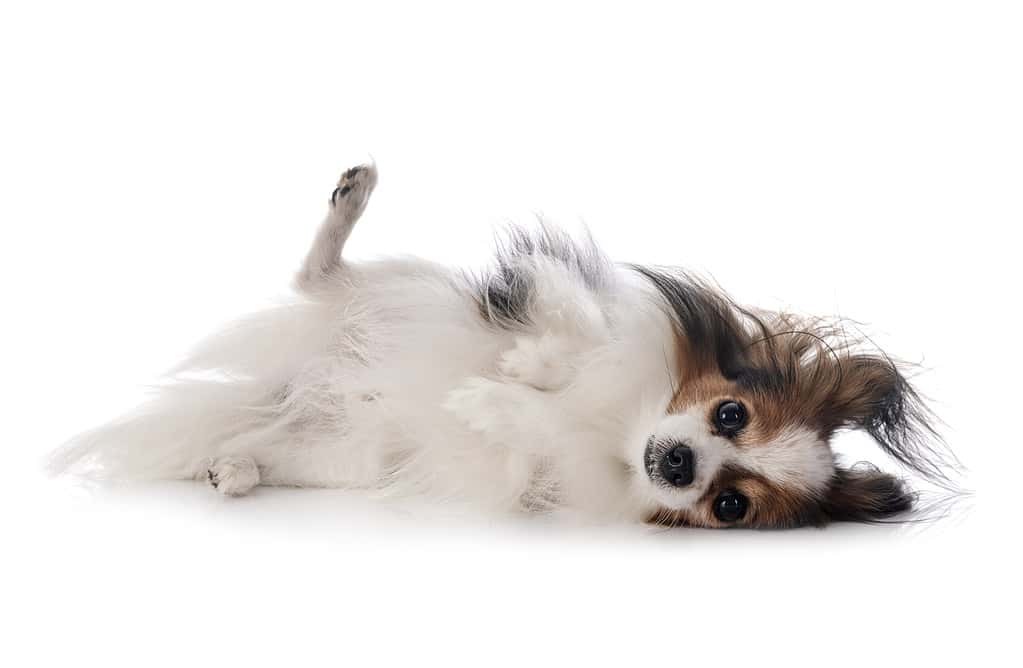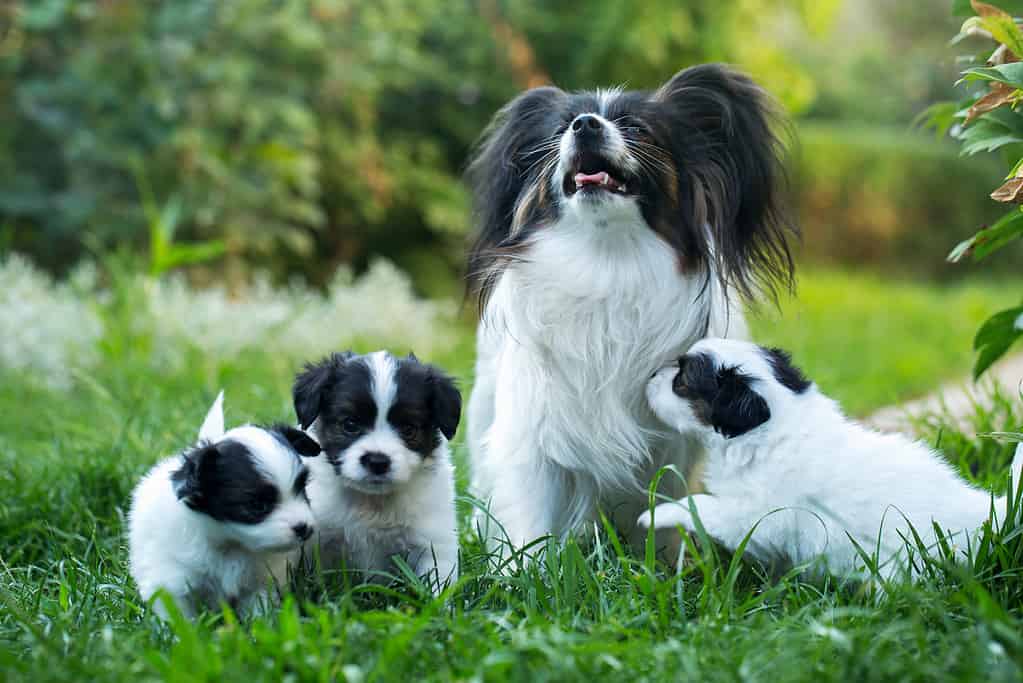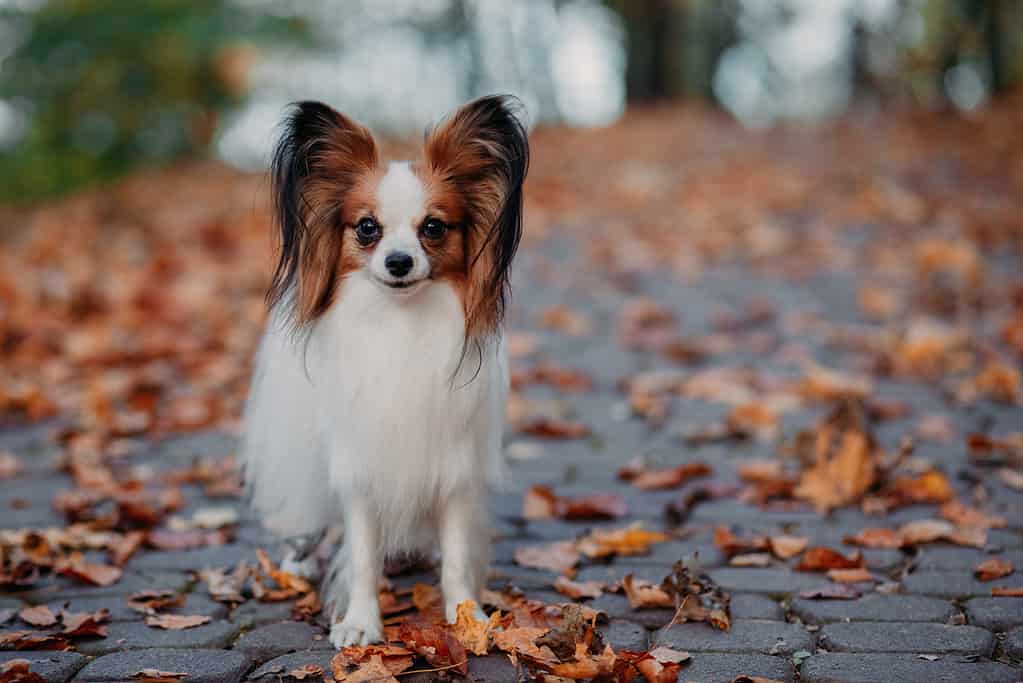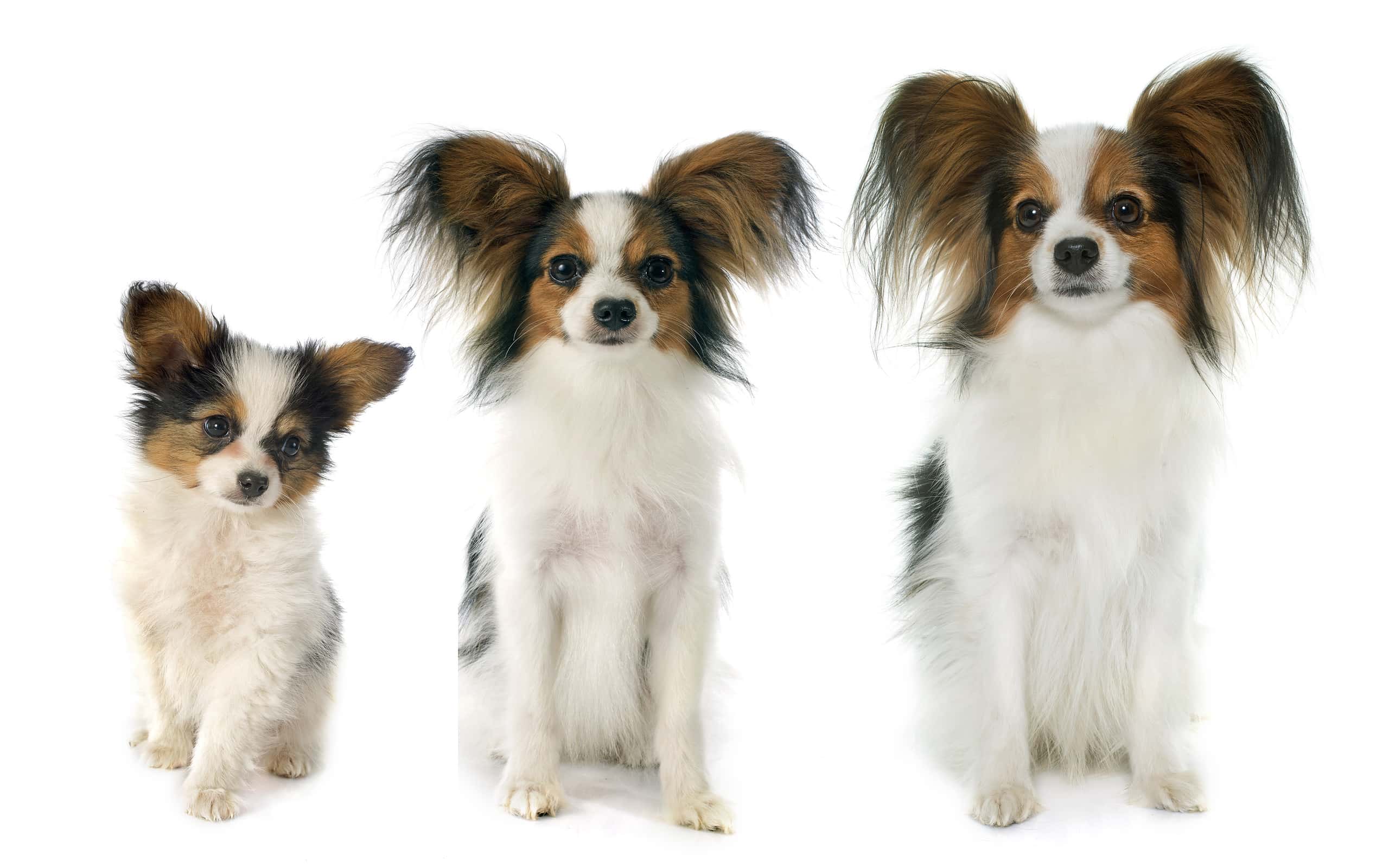Papillon Summary
The Papillon is a small breed that’s known for their distinctive butterfly-like ears. In fact, their name “Papillon” means “butterfly” in French. These tiny dogs are typically bred as companion animals and are known for their friendly, intelligent nature. However, they’re also pretty lively and alert.
Papillon Growth and Weight Chart by Age
| Age | Weight Range |
|---|---|
| 2 months | 1.5 – 2.5 pounds |
| 3 months | 2 – 4 pounds |
| 4 months | 2.5 – 4.5 pounds |
| 5 months | 3 – 5 pounds |
| 6 months | 3.5 – 6 pounds |
| 8 months | 4 – 7 pounds |
| 10 months | 4.5 – 8 pounds |
| 12 months | 5 – 10 pounds |
While this chart does provide the general guidelines for the weight range of a Papillon dog at different ages, individuals can vary. Your dog may not be within these “normal” ranges, which may be completely okay! Consult with your vet if you’re concerned about your pet’s weight.
When Will My Papillon Stop Growing?
Papillons are smaller dogs, so they usually don’t require much time to grow. They reach their full size sometime around 9 to 12 months of age. However, the rate of growth can vary from dog to dog. Smaller dogs usually get done growing before larger ones, even within the same breed.
It’s important for Papillon owners to be mindful of their dog’s weight during this time. Puppies do need more calories and nutrients than adult dogs. However, that doesn’t mean you shouldn’t monitor your dog’s food intake. Avoiding obesity starts now when the dog is still a puppy.
Adult Papillons typically eat between 1/4 and 1/2 cups of food per day. It’s important to follow the instructions on the food packaging, but you can adjust the amount as needed. Puppies usually require at least three meals per day, but as they grow into adults, two meals per day are usually sufficient.
Regular vet checkups are necessary to ensure your Papillon is growing properly. Puppies require very frequent vet visits, as they are growing and changing very rapidly. Plus, they also need vaccinations at regular intervals. As your dog turns into an adult, they typically only need an annual check-up.
Regular vet visits are particularly important to prevent your canine from gaining too much weight. Your dog will be weighed at each checkup, which can help the vet determine if your dog is overweight.
How Big Will My Papillon Be When It’s Fully Grown?

Papillons typically reach their full height first, but they may take several months to gain their adult muscle mass.
©cynoclub/iStock via Getty Images
When fully grown, the average Papillon is around 5 to 10 pounds and 8 to 11 inches at the shoulder. However, individual dogs can fall outside of this range. Genetics, diet, and health can all play a role in their final size.
Genetics are the biggest factor in determining a Papillon’s size, and most are bred specifically to fall within the breed standard. However, if your dog isn’t properly fed, they may end up smaller than their “genetic potential” would dictate.
You can get a good idea of how large your Papillon maybe by looking at their parents. Most quality breeders can provide you with a good guess, too.
When Should My Papillon Be Spayed or Neutered?
There are two main schools of thought when it comes to spaying or neutering your Papillon. One claims that you should spay or neuter your dog as early as possible. Doing the procedure early helps prevent the chance of accidental pregnancies (which can be very tough on dogs at this age). Plus, spaying and neutering are associated with health benefits.
However, dogs do need some of the hormones produced by their reproduction organs to grow properly. When they are spayed or neutered early, there is a higher chance of growth problems.
That said, larger dogs typically take the brunt of these problems, not smaller ones like the Papillon. Therefore, vets are more likely to recommend that smaller dogs undergo the surgery sooner.
The best way to determine the correct age for your dog is to discuss it with your vet. Your lifestyle and other risk facts may indicate an earlier or later spaying or neutering date.
When Should My Papillon Be House Broken?
You should start housebreaking your canine as early as possible. Many breeders will start before they even send their dogs to their new home. However, even if they haven’t, you should absolutely start the second you bring your puppy into your home.
Papillons are smaller dogs, which means they have smaller bladders. Therefore, they usually need to use the bathroom more often, which can make potty training more of a challenge. It can take several months of training for your dog to be pretty much potty trained.
Start by establishing a routine as soon as you bring your puppy home. Often, puppies need to go outside after waking up, meals, and play sessions. Always lean closer to going outside too much than not enough.
When your puppy is inside, always keep a close eye on them. The second you notice them sniffing around or acting like they need to use the bathroom, rush them outside. When your Papillon does successfully use the bathroom outside, praise and reward them right away. Positive reinforcement helps them associate going to the bathroom outside with positive experiences.
As always, be patient. Your puppy will probably have an accident or two. Expecting accidents and preparing for them properly can help reduce the chance of you becoming frustrated when it does happen. Avoid punishing your puppy for accidents, as this may only cause them to become anxious around the whole experience.
When Should My Papillon Stop Eating Puppy Food?
You should begin transitioning your Papillion from puppy food whenever they begin approaching their adult size. Puppy food contains extra nutrients and calories that are essential for a growing puppy. However, whenever your puppy’s growth slows down, they no longer need it.
In fact, continuing puppy food for too long can lead to excessive weight gain, as your dog will be consuming too many calories.
For most Papillions, growth will stop by 12 months. However, some smaller ones may stop growing at 9 months. Therefore, it’s important to monitor your dog’s weight and start switching to adult food whenever it has slowed considerably.
Remember, this is a transition, not an overnight switch. You should begin by mixing a very small amount of adult food with their puppy food (removing a small amount of puppy food). Slowly increase the amount of adult food while decreasing the amount of puppy food over 7-10 days.
If your puppy has digestive issues, reduce the amount of adult food and transition slower. Some dogs simply take longer to adjust to a new food than others.
When Will My Papillion Start Lowing Teeth?
Like all dogs, Papillion puppies begin losing their teeth around 3 to 4 months. It often takes a few months for this process to become complete, so you can expect it to finish around 6 months at the latest. There is a whole range of normal here, though. Your dog can fall outside this schedule, which is still normal.
Losing their puppy teeth isn’t exactly comfortable, so many dogs will begin to chew excessively during this period. To save your couch legs, invest in quality chew toys. Start with a variety until you figure out what your puppy likes.
Praise your dog when they use the correct chew toys. If they start chewing on something they shouldn’t, redirect them to a chew toy and then praise them when they begin to use it. Your house needs to be puppy-proof during this period, as they’re far more likely to chew on things they shouldn’t.
If you haven’t already, now is a great time to start toothbrushing. Use a dog-friendly toothbrush and toothpaste to maintain good dental health.
When Should I Start Training My Papillion?
Your puppy will begin learning as soon as they step into your home. Therefore, it’s important that you begin training them consciously. Otherwise, there is a chance that they will pick up on bad habits, which can be hard to get rid of.
Many quality breeders will begin teaching their puppies early. However, you will need to continue this process at home. Early training will be fairly simple and mostly include good habits (not biting people), potty training, and socialization.
Socialization is the most important part of this process. While cues are important, socialization prevents your dog from being fearful of new people and places, effectively preventing fear-driven aggression. To socialize your dog, introduce them to as many people and places as you possibly can at an early age.
Keep all dedicated training sessions short. Young puppies can only learn for five or so minutes at a time. As they practice, their attention span will expand.
Be patient and consistent. Puppies take a while to learn just about anything. At this point, you’re mostly getting them used to the process of training and listening to their owner.
What Cues Should I Teach My Papillion First?
When training cues, always use positive reinforcement. This training method is based on science and encourages dogs to want to train and obey. Therefore, it’s much more effective than other options.
While you can use some creativity when deciding what cues to teach, there is a general outline that you should follow. Some commands simply require others to be taught first, and others are simply necessary for your dog to thrive.
Here’s the order we recommend teaching cues:
- Sit: This command is required for tons of other commands. Therefore, you should teach it first. (It’s also one of the easier cues.)
- Stay: “Stay” is a crucial command for safety. Start with very short durations and gradually increase the time your puppy stays in one place.
- Come: You can teach come at the same time as stay. However, you should make a point to practice in a variety of settings. It can be crucial for safety, but you often need it when your dog is distracted.
- Lie Down: Similar to “sit,” teaching your Papillon to lie down provides you with another way to control their movements and behavior.
- Heel: Your Papillon probably won’t be as hard to walk on a leash as other breeds. However, teaching your dog to heel can still make walking much more calming and enjoyable.
When Will My Papillion Calm Down?
Papillions aren’t exceptionally active dogs. However, they do require some amount of exercise. Otherwise, they can be hyperactive no matter their age.
Of course, puppies naturally tend to be more energetic and playful than adults. Typically, this puppy exuberance will dissipate around one to two years of age. That said, you can’t expect your dog’s behavior to be like a switch flipping, and there is plenty you can do to help your dog behave a bit better.
Consistent and positive training can contribute significantly to managing a Papillon’s energy levels. Well-trained dogs tend to be more responsive to commands and can be better behaved overall. You have to teach your dog to behave indoors. If you don’t, they may continue to be hyperactive.
These dogs do need exercise, though, as we have already stated. Therefore, if your dog is hyperactive, you may need to increase their exercise. They also need some degree of mental stimulation and may be hyperactive when bored, too. Therefore, you should look to stimulate your dog more if you think they’re more hyperactive than they should be.
Spaying and neutering your Papillion can also influence their behavior. Sometimes, it may lead to a calmer demeanor. Individual responses can vary, though.
Some dogs just have a genetic predisposition to be more hyperactive than others. This can be the result of poor breeding, but it may also just be the decision of the breeder. Sometimes, breeders aim to create more energetic dogs for their more active clientele. Ask your breeder what you can expect from your canine.
Common Health Issues Your Papillion Might Experience
Generally, these dogs are more healthy than others. They usually don’t have any major medical issues, especially when you purchase from a quality breeder. However, they can still be prone to some health problems.
- Patellar Luxation: This condition is partially genetic and mostly seen in smaller dogs like the Papillion. When this condition occurs, the kneecap slips out of position. Your dog will probably walk weirdly and maybe in some pain. Luckily, treatment is usually pretty straightforward.
- Dental Problems: All dogs can be prone to dental issues, especially if their teeth aren’t brushed regularly. Smaller dogs can have more overcrowding than larger dogs, which can cause more dental problems.
- Eye Problems: Papillons can be at a higher risk of progressive retinal atrophy. This condition develops in adults around 3 to 9 years old. Sadly, it is progressive and incurable. Therefore, affected dogs will go blind eventually.
- Allergies: Papillons can have a certain type of allergy that makes their skin itchy when it comes into contact with an allergen like pollen or mold. This itchiness often develops at a pretty easy age and continues to worsen. Most dogs need medication to prevent them from chewing their skin raw.
- Portosystemic shunt: In this condition, the liver doesn’t properly remove the proteins, nutrients, and toxins from the bloodstream that it is supposed to. This condition is usually present at birth and likely has a genetic cause.
- Collapsing trachea: This condition most commonly occurs in small dogs, usually older ones. As the name suggests, the trachea collapses as the structural rings weaken.
Pictures of Papillions as Puppies

Papillion puppies do not have the “
butterfly
” ears that adults have. It takes them several months to grow out their fur.
©Mallivan/iStock via Getty Images
Pictures of Papillions at 6 Months

At six months, these dogs often look fully grown. However, they are often a bit skinny and have some muscle mass left to gain.
©Andybir/iStock via Getty Images
Pictures of Fully Grown Papillions

Papillions are small, even as adults. Their coat does need quite a bit of grooming, as it is prone to tangles.
©iStock.com/Nadezhda Braninger
Ready to discover the top 10 cutest dog breeds in the entire world?
How about the fastest dogs, the largest dogs and those that are -- quite frankly -- just the kindest dogs on the planet? Each day, AZ Animals sends out lists just like this to our thousands of email subscribers. And the best part? It's FREE. Join today by entering your email below.
Thank you for reading! Have some feedback for us? Contact the AZ Animals editorial team.








